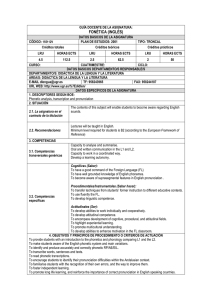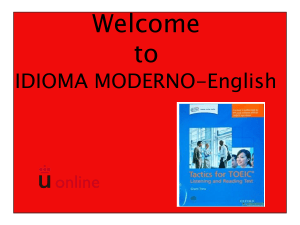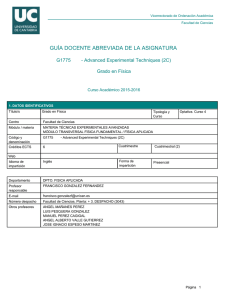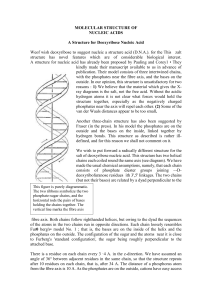Cognitive Base of Social Interactions and Communication
Anuncio
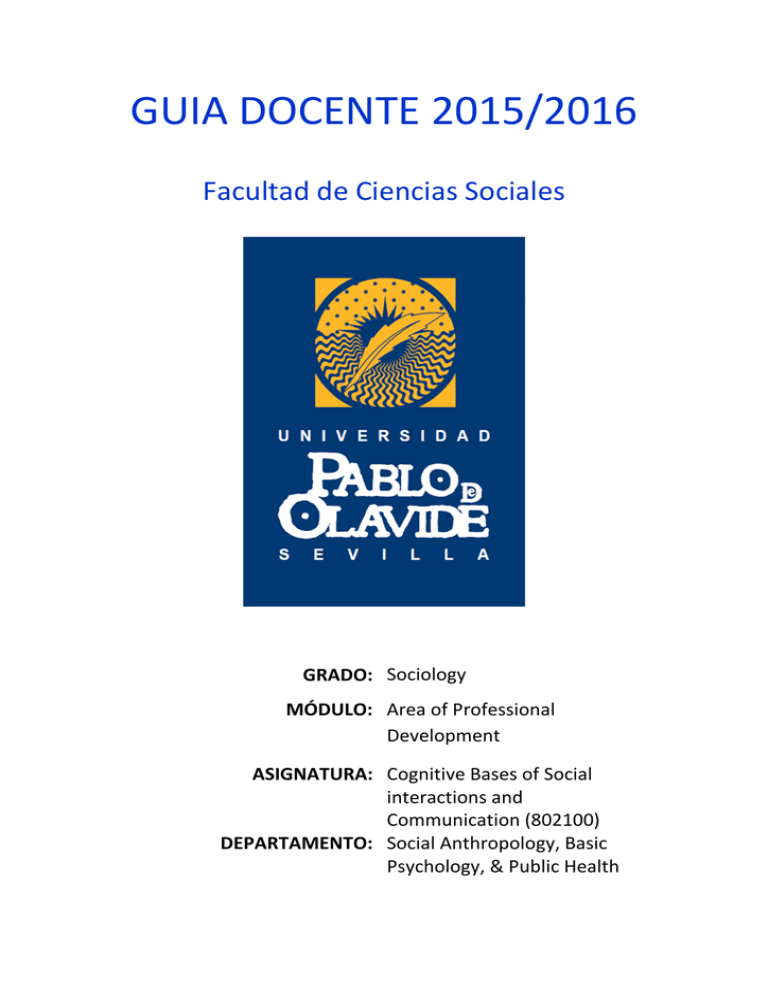
GUIA DOCENTE 2015/2016 Facultad de Ciencias Sociales GRADO: Sociology MÓDULO: Area of Professional Development ASIGNATURA: Cognitive Bases of Social interactions and Communication (802100) DEPARTAMENTO: Social Anthropology, Basic Psychology, & Public Health GUIA DOCENTE Cognitive Bases of Social interactions and Communication GRADO: MÓDULO: Sociology Area of Professional Development MATERIA: Social and Institutional Processes ASIGNATURA: Cognitive Bases of Social interactions and Communication - 802101 Social Anthropology, Basic Psychology, & Public Health DEPARTAMENTO: 1. DATOS DE SITUACIÓN CRÉDITOS TOTALES: CURSO: SEMESTRE: CARÁCTER: PRERREQUISITOS: LENGUA DE IMPARTICIÓN: 6 ECT 4º First Optional subject English MODELO DE DOCENCIA: a. Enseñanzas básicas: b. Enseñanzas prácticas y desarrollo: c. Actividades dirigidas: A1 70 % 30 % 2. OBJETIVOS DEFINIDOS EN TÉRMINOS DE COMPETENCIAS (SABER, SABER HACER Y SABER SER). 2.1. COMPETENCIAS DEL VERIFICA 2.1.1. Competencias generales del módulo que se trabajan en la asignatura G6 - Identifying the global and local characters of social phenomena G8 - Competence to work in multicultural and international contexts G9 - Competence to work in interdisciplinary teams G11 – Domain of a foreign language (English as a second language) 2 GUIA DOCENTE Cognitive Bases of Social interactions and Communication 2.1.2. Otras competencias generales de la asignatura. 1. Competence to manage information 2. Critical Thinking 3. Development of autonomous learning 4. Competence for knowledge communication 5. Interpersonal competences: working in group, working in interdisciplinary teams and in international and multicultural contexts. 6. Ethical Commitment, responsibility democratic values and social 2.1.3. Competencias específicas del módulo que se trabajan en la asignatura del Verifica E23 – Professional Responsibility E7 – Universal Human Rights Commitment E8 – Gender Equality Commitment E10 – Democratic Values E11 – Ethical Commitment 2.1.4. Otras competencias específicas de la asignatura 1. Understanding and Analyzing social interactions in practices of everyday life. 2. Understanding communicative processes created in the Globalization and their consequences, such as the great social, cultural, technological and cognitive transformations. 3. Applaying these competences to the profesional practices of sociologists and other social scientists. 4. Developing several kinds of literacy, discursive practices and form of reasoning in public context: 5. Narrative literacy: Description of dayly-life events through writing and oral expression (secondary orality). 6. Academic literacy: Understanding and writing essays and academic texts 7. Training in public debates. 3 GUIA DOCENTE Cognitive Bases of Social interactions and Communication 2.2. Otros resultados de aprendizaje para otras competencias generales Showing in a practical way competences for critical thinking, interpersonal relationships, and ethical commitment. 3. UBICACIÓN EN EL PLAN FORMATIVO At the end of Sociology degree when other basic competences have been co-constructed. 4. CONTENIDOS DE LA ASIGNATURA Social interaction and communication. Models and Methodologyof Social Intervention. An evolutionary perspective for study of interactions and communicative processes: The interface between nature and culture. Media communication: Actions, signs, language, imagery, and technologies. Eviroments, Spaces, Habitats. The Ecology of Social interaction. Ways for Socialization. Media communication Theory. The Toronto School of Communication and its contributions to the study of Culture and Technology. Modes of discourse and form of thinking. Narrative, Rhetorics. Constitution processes of idendities and the promotion of life-in-common. Models and Methodologyof Social Intervention. 4.1. TEMARIO PARA LA ASIGNATURA An evolutionary perspective for study of interactions and communicative processes: The interface between nature and culture. Can Culture interves in Human Evolution? A case for study. Mutations related with changes in (agri)culture. An evolutionary perspective for study of interactions and communicative processes: Tools, signs and technology in pre-sapiens and sapiens. Media communication: Action, signs, language, imagery, and technology. The Toronto School of Communication (Innis, McLuhan, Havelock and Ong). Its contibutions to the study of Culture, Technology and the technology as culture. Semiotic mediation. The theory of Lev S. Vygotsky. Civilization process. Rituals and signs. 4 GUIA DOCENTE Cognitive Bases of Social interactions and Communication Enviroments, Spaces, Habitats. The Ecology of social interaction and life in common. Forms of community: Primary communities vs imaged communities; collectivism vs individualism… From sphere to globe (Ingold). Architectonics of Habitats and the creation of communities. Representations of Sacred and prophane (Eliada). Places and non-places (Augé). The futures of cities or city for the future. Modes of discourse and forms of thinking. The function of contexts in language communication. From the action grammar to the language grammar. Egocentric and inner speech. Discourse in dyadic relationships. Orality and Literacy: A cultural historical analysis of social-cognitive changes. Ways for Socialization. Intersubjectivity and dialogism. Collectivism and individualism in social interactions. Teaching and learning in daily-life practicies. Formal education as a dialogical practice. Narrative and Rhetorics. Constitution processes of identities and the promotion of life-in-common. Narratives and experience. Self narrative: Dramatistic dimensión of discourse (Garfinkel, Habermas). Rhetoric of discourse in public sphere 5. METODOLOGÍA Y RECURSOS Pattern A1 Basic teaching (70%). Incorporating theoretical teaching, methodology, main concepts and topics of the discipline, etc. Several activities related to the main subject topics (lectures, projections, contacts with other professor and students, etc.). Practical classes for the subject development (30%). Use of ICT and debates en social network. Presentations in power-point. Analysis of text, imagen and videos.EPD entitled “Arte & Society: Multimodal workshop of social sciences” Note: Every case of any student with functional problems to follow the course on a regular bases will be individually considered. 5 GUIA DOCENTE Cognitive Bases of Social interactions and Communication 6. EVALUATION Overall evaluation system % 45.0-55.0 45.0-55.0 Exam and personal paper Practical activities Specific evaluation Written exam (45%) Two reports related to the contents of several parts of program (5%). An individual essay about one topic from the program supervised by the professor (30%). EPD: Arte, Technology, and Society: Multimodal workshop for social sciences” (20%). Evaluation normative of students degree at the University Pablo de Olavide will be fulfilled. 7. EQUIPO DOCENTE Nombre: Número despacho: Email: Teléfono. Juan Daniel Ramírez Garrido 14 [email protected] (34) 954 348 937 8. BIBLIOGRAFÍA GENERAL References BAKHTIN, M. M. (1986a). Speech Genres & Other Late Essays. Austin, Texas: University of Texas Press. BRUNER, J. (1988). Realidades mentales y mundos posibles. Barcelona: Gedisa. BURKE, K. (1969). The Grammar of Motives. Berkely and Los Angeles: University of California Press. CAREY, J. W. (1989). Communication as Culture. Essays on Media and Society. New York: Routledge. GEERTZ, C. (1987). La interpretación de las culturas. México: Gedisa. HABERMAS, J. (1987a). Teoría de la acción comunicativa. Vol. II: Crítica 6 GUIA DOCENTE Cognitive Bases of Social interactions and Communication de la razón funcionalista. Madrid: Taurus. HABERMAS, J. (1987a). Teoría de la acción comunicativa. Vol.I: Racionalidad de la acción y racionalización social. Madrid: Taurus. HODGE, R. & KRESS, G. (1988). Social Semiotic. Cambridge, UK: Polity Press. INNIS, H. A. (1951/1999). The Bias of Communication. Toronto: University of Toronto Press. McLUHAN, M. (1962). The Gutenberg Galaxy. Toronto: University of Toronto Press. MEAD, G. H. (1982). Espíritu, persona y sociedad. Barcelona: Paidos. OLSON, D. R. (1994). The World on Paper. Cambrdige: Cambridge University Press (trad: El mundo sobre el papel. El impacto de la escritura y la lectura en la estructura del conocimiento. Barcelona: Gedisa, 1998). RAMIREZ, J. D. & J. V. WERTSCH (1997). Discourse in Adult Classroom. Rhetoric as Technology for Dialogue. En L. Resnick, R. Saljo, & C. Potecorvo, & B. Burge (Eds.). Situated Cognition and Technologycally Supported Enviroments. Berlin Heidelberg: Springer-Verlag (cl). RAMIREZ, J. D. (1995). Usos de la palabra y sus tecnologías. Una aproximación dialógica al estudio de la alfabetización. Buenos Aires: Miño y Dávila Editores. RAMIREZ, J. D. y SÁNCHEZ, J. (1995) Etica, retórica y educación. El nexo dialógico. Hacia un currículum cultural. La vigencia de Vygotski en la educación (págs. 133-145). Madrid: Fundación Infancia y Aprendizaje. VAN LEEUWEN, T. & JEWITT, C. (2001). Handbook lf Visual Analysis. London, UK: Sage. VYGOTSKI, L. S. (1993). Pensamiento y lenguaje. En L. S. Vygotski. Obras escogidas (II). Madrid: Aprendizaje-Visor. WERTSCH, J. V. (1985). Vygotsky. La formación social de la mente. Barcelona: Paidos, 1988. 7
